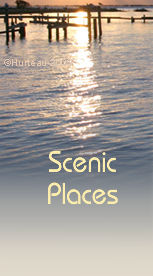 |
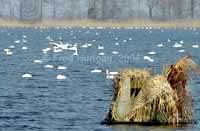 |
| Hunting
and fishing is permitted seasonally on the lake. |
Lake
Mattamuskeet
(Mattamuskeet National Wildlife Refuge)
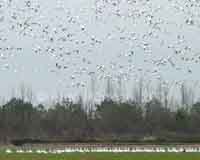 |
| Thousands
of snow geese feed in the farm fields around the
lake. |
The 40,000 acre Lake Mattamuskeet,
18 miles long and 6 miles wide(1), is surrounded
by over 6,000 acres of freshwater marsh and forested wetlands(1).
This natural lake, the largest in North Carolina, is a
mecca for bird-watching enthusiasts. It has been a national
wildlife refuge since 1934.
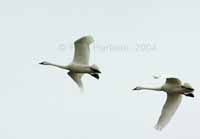 |
| Tundra
swans by the tens of thousands winter at Lake Mattamuskeet. |
In the 16th century, when the first
English explorers along North Carolina's coast visited
the lake, it covered three times its present area. Ever
since that time there has been interest in draining the
lake to make fertile farmland. Early attempts to do so
in the 1700's were nixed or thwarted. But in 1837 a canal
was finally dug from the lake to Wysocking Bay on Pamlico
Sound. This drained all the water from the lake that was
above sea level, shrinking the lake from 120,000 acres
to just 55,000 acres(3). Since the remainder
of the water was below sea level, it would have to be
pumped out. During the 25 years between 1909 and 1934
the lake was pumped completely empty three different times
as part of the effort to convert it and surrounding land
for farming(3).
 |
| The
pumping station still provides an eye-catching visitor
attraction. |
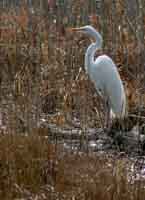 |
| Many
egrets, herons and other wading birds are found
in the marsh areas surrounding the lake. |
This was a gargantuan and costly
effort, requiring the dredging of more than 100 miles
of canals and the construction of a huge pumping plant
to lift the water from the lake level into the main canal
which carried it to the sound. In the end the massive
efforts ended in failures and bankruptcies. The pumping
plant was eventually turned into a hotel and restaurant,
and served as a popular hunting lodge for many years.
Presently the building is closed due to corrosion of the
steel supporting structure, making it unsafe for visitors.
It is in the precess of being repaired and restored, but
the project is taking far too long to complete. A much
more detailed history is available at www.mattamuskeet.org.
Today Lake Mattamuskeet is well-known
for the vast flocks of wintering tundra swans estimated
at up to 35,000(1). Canada geese and snow geese
numbering 6,000-11,000(1) or more also gather
here between November and January. Its location along
the Atlantic Flyway makes it a prime site for viewing
migratory birds of many species. It is home seasonally
to more than 240(1) species of birds, including
bald eagles, peregrine falcons, osprey, and a great variety
of ducks and shorebirds(2).
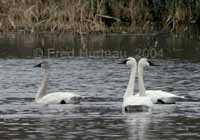 |
|
| Tundra
swans are a big attraction for bird watchers. |
Neighboring Swan Quarter National
Wildlife Refuge compliments Lake Mattamuskeet. It provides
additional protected marshland and sound waters where
visitors can view the plethora of ducks, geese, swans,
wading birds and raptors that are found here.
(1)
Figures from U.S. Fish & Wildlife Service
(2) Information from U.S. Fish & Wildlife Service
(3) Figures and historical information from www.mattamuskeet.org
|
|
|

